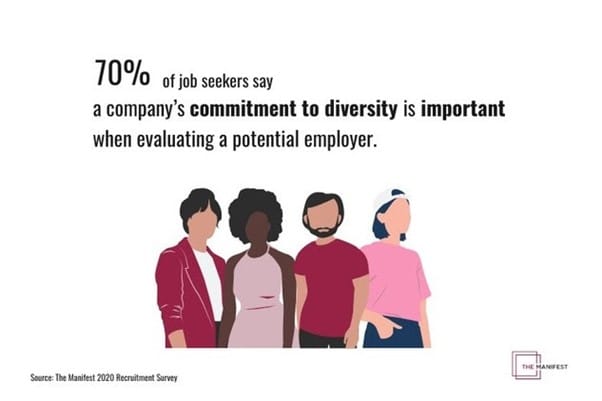5 Verified Steps To Implementing Diversity and Inclusion in a Remote Workforce

The McKinsey research has proven the importance of diversity and inclusion. It has gone from a nice-to-have to a mandatory element. However, with the pandemic and the ever-changing landscape of business, there are concerns that remote work may worsen the case of diversity and inclusion.
But that need not be the case. Therefore, this post shall examine 5 ironclad tips for implementing diversity and inclusion when an organization switches to remote work.
-
Prioritize diversity and inclusion from the get-go
Implementing diversity and inclusion in a remote work environment begins with a conscious decision on the part of the organization to welcome and celebrate differences.
Thus, the business should ensure that there is an ongoing process that ensures diversity and inclusion right from the stage of remote recruiting down to hiring and remote working.
The company needs to institute practices that improve accessibility to the hiring process and ensure diversity and inclusion in video interviews. Some steps to actually achieve this include:
- Creating more inclusive job postings by utilizing inclusive words such as gender-neutral words, while avoiding words that negatively impact certain groups of people.
- Pinpointing and appraising current hiring prejudices. Being wary of bias is the most effective way to spot and nip it in the bud.
- Ensuring that attention is paid primarily to the skills, abilities, and experiences of the candidates, instead of superficial elements such as their names, race, nationality, gender, etc.
 Image Source: Cision PR Newswire
Image Source: Cision PR Newswire
Lots of candidates consider a company’s diversity and inclusion values when job-hunting. Therefore, if an organization values and implements diversity and inclusion, it will invariably attract a diverse workforce.
-
Give your employees a voice, and listen
Do you know that remote working could cause a lot of things to go unnoticed?
Regularly have one-on-one virtual meetings, and get feedback from your employees to be sure that your organization is truly implementing diversity and inclusion in the remote work setting.
There is nothing wrong with enhancing the voice of your workforce and giving them a platform.
Ask your employees if they feel the company is doing well with its diversity and inclusion initiatives. Take note of their responses, and make the necessary adjustments.
Do they feel that they have equal opportunities in terms of pay, promotion chances, learning and development opportunities, and assignments? Discuss these issues with them to get an idea of where they stand.
This is crucial because communication is a pillar of inclusion, and is imperative when there’s a work-from-home plan.
What else? Business owners can also give employees the space to create resource groups. Such resource groups are an avenue to foster connection and cater to the extra-professional needs and concerns of the employees.
-
Understand and adjust to the complexities of a diverse team
Diversity comes in various forms such as age, gender, race, sexual orientation, nationality, financial background, religion, thinking process, etc. True inclusion emphasizes coming to terms with the differences, welcoming them, and even celebrating them.
Everyone has their own preferences, and the differences between groups can become quite glaring when they are working from home. For example, some will prefer a text, while others will prefer a call.
To genuinely ensure diversity and inclusion in such a situation, business leaders need to bear in mind that these differences exist, and thus not make the mistake of favouring one group more than the other.
The UK’s Equality Act emphasizes equal treatment of all employees, but here are some noteworthy points for business leaders:
- Be more understanding of the differences in preferences
- Have a positive outlook and assume the best intentions of each group
- Pick a suitable pattern and style of communication
- Communicate your expectations clearly
- Create fair rewarding and promotion policies that are based on performance, output, and engagement, instead of discriminatory elements such as age, etc.
-
Emphasize mutual respect and acceptance
Working from home does not eliminate the need for mutual respect and acceptance amongst the employees of a company.
In fact, if anything, it throws its importance into focus, because it’s mandatory for the team to work together to accomplish their goals.
As we mentioned earlier in our post on the meaning of diversity and inclusion, inclusion is a two-way process. This means that each employee must give and receive respect and acceptance. Some tips on how to emphasize respect and acceptance in a remote work environment are:
- When fixing meetings and other group activities, ensure that the time and virtual location work for everyone. Be sure that no one is excluded for the wrong reasons.
- During conversations, listen to what others have to say before voicing your opinions. People have varying degrees of knowledge in different fields. Learn from others in areas that might not be your field of expertise.
- Do not patronize, or talk down to others, regardless of the situation. Don’t condemn nor judge others either. Such moves can leave a lasting negative impression. We are all equal.
- Practice transparency, common courtesy, and politeness. Also, delegate meaningful tasks and projects.
- Recognize the strengths of others, while acknowledging everyone’s contributions and accomplishments.
-
Set benchmarks, and pay due attention
I’m sure you’ve heard the expressions “numbers don’t lie” and “what gets measured gets done”.
These expressions hold true because the measurement is crucial to the success of diversity and inclusion initiatives, particularly in a work-from-home setting.
Without a process to track the success of your company’s diversity and inclusion efforts, there is the possibility of reverting to subtle thoughts and operation patterns that are not inclusive.
Setting targets helps business leaders by encouraging the uncovering and tackling of bias blindspots that go unnoticed.
Targets and key metrics when implementing diversity and inclusion in a remote workforce help to:
- Identify risk areas
- Prioritize initiatives
- Measure the impact of initiatives
- Assign accountability
- Set new goals
If the metrics prove financial return on investment, they can be used to engage stakeholders, strengthen leadership commitment, and secure additional resources to push for more change. Also, if the metrics prove equality and fairness, they can be used to foster employee engagement and employee trust, and also strengthen the brand’s reputation.
Tips for setting standards when implementing diversity and inclusion
a) Define the diversity dimensions to be monitored. Depending on the business goals and the nature of the society in which the business finds itself, diversity measurement should extend to age, gender, race, ethnicity, nationality, academic level, religion, health status, etc.
b) Set goals because they help individuals focus in a particular direction. Without goals, there will be a lack of motivation, and subtle biases will erase the attempts at fairness.
c) After goal-setting, responsibility for their achievement should be assigned to individuals who are to be held accountable through performance management tools.
d) Track and analyse the results to assess what’s working, and what isn’t. Your discoveries will be used to determine what modifications to the initial action plan are required.
So, if your organization has switched from in-office work for the moment, these steps will help achieve the diversity and inclusion goals, regardless of the remote work development. Check out our Shine video interviewing software for a good starting point!
